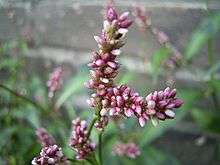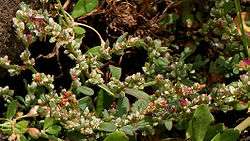Polygonum
| Polygonum | |
|---|---|
| Polygonum aviculare | |
| Scientific classification | |
| Kingdom: | Plantae |
| Clade: | Angiosperms |
| Clade: | Eudicots |
| Order: | Caryophyllales |
| Family: | Polygonaceae |
| Subfamily: | Polygonoideae |
| Genus: | Polygonum L. |
| Species | |
|
About 220 accepted species; see text | |
Polygonum is a genus of about 220 species of flowering plant in the buckwheat and knotweed family Polygonaceae. Common names include knotweed, knotgrass, bistort, tearthumb, mile-a-minute, smartweed and several others. In the Middle English glossary of herbs Alphita (c. 1400–1425), it was known as ars-smerte.[1] There have been various opinions about how broadly the genus should be defined. For example, Buckwheat (Fagopyrum esculentum) has sometimes been included in the genus as Polygonum fagopyrum.
The genus primarily grows in northern temperate regions. The species are very diverse, ranging from prostrate herbaceous annual plants under 5 cm (2 in) high to erect herbaceous perennial plants growing up to 3–4 m (10–13 ft) tall to perennial woody vines growing up to 20–30 m (66–98 ft) high in trees. Several are aquatic, growing as floating plants in ponds. The smooth-edged leaves range from 1–30 cm (0.39–11.81 in) long, and vary in shape between species from narrow lanceolate to oval, broad triangular, heart-shaped, or arrowhead forms. The stems are often reddish or red-speckled. The small flowers are pink, white, or greenish, forming in summer in dense clusters from the leaf joints or stem apices.
The genus name is from the Greek poly = "many" and gonu = "knee" or "joint", in reference to the swollen jointed stem.
Polygonum species are occasionally eaten by humans, and are used as food plants by the larvae of some Lepidoptera species – see list. Most species are considered weedy, especially in moist soils in the USA.
Distribution and uses
Several species can be eaten cooked,[2] for example during famines.[3] The species Polygonum cognatum, known locally as "madimak",[4][5] is regularly consumed in central parts of Turkey.
In Chinese medicine, a Polygonum extract called Rèlínqīng Kēlì (热林清颗粒) is used to treat urinary tract infections.[6] Chinese medicine also uses a Polygonum multiflorum extract called Fo-Ti.
Care should be taken not to confuse Polygonum with Polygonatum – an entirely different genus of plants.
References in literature
In The Man Who Laughs Victor Hugo wrote of the Comprachicos (child-buyers) who created artificial dwarfs, formed "by anointing babies' spines with the grease of bats, moles and dormice" and using drugs such as "dwarf elder, knotgrass, and daisy juice". The idea of such use was also known to Shakespeare, as Beatrice K. Otto pointed out, quoting A Midsummer Night's Dream:[7]
Get you gone, dwarf;
You minimus, of hindering knot-grass made;
Species
Between 65[8] and 300 species have been recognised at various times, depending on the circumscription of the genus. About 200 species are currently accepted.[9] A number of species that had been included in Polygonum have been moved into several other genera, including Fagopyrum, Fallopia, Persicaria and Reynoutria.
Accepted species include:[9]
- Polygonum achoreum S.F. Blake
- Polygonum affine D.Don (Persicaria affinis is a synonym)
- Polygonum albanicum Jáv.
- Polygonum arenastrum Boreau – equal-leaved knotgrass
- Polygonum argyrocoleon Steud. ex Kunze
- Polygonum aviculare L. – common knotgrass
- Polygonum bidwelliae S. Watson
- Polygonum bolanderi W.H.Brewer
- Polygonum californicum Meisn. – California knotweed
- Polygonum cascadense W.H.Baker
- Polygonum cognatum Meisn. – Madimak or Indian knotgrass
- Polygonum douglasii Greene – Douglas' knotweed
- Polygonum emodi Meisn.
- Polygonum erectum L.
- Polygonum fowleri B.L. Rob.
- Polygonum glaucum Nutt.
- Polygonum heterosepalum M. Peck & Ownbey – dwarf desert knotweed
- Polygonum hickmanii H.R. Hinds & Rand. Morgan
- Polygonum humifusum C. Merck ex K. Koch
- Polygonum japonicum Meisn.
- Polygonum macrophyllum D.Don (Persicaria macrophylla is a synonym)
- Polygonum milletii (H. Lév.) H. Lév. (Persicaria milletii is a synonym)
- Polygonum majus (Meisn.) Piper
- Polygonum marinense T.R. Mert. & P.H. Raven
- Polygonum minimum S.Watson – broadleaf knotweed
- Polygonum nuttallii Small
- Polygonum oxyspermum C.A.Mey. & Bunge – Ray's knotgrass
- Polygonum paronychia Cham. & Schltdl.
- Polygonum parryi Greene
- Polygonum patulum M.Bieb. – Bellard's smartweed
- Polygonum perfoliatum L. – mile-a-minute weed
- Polygonum plebeium R.Br.
- Polygonum polygaloides Meisn.
- Polygonum ramosissimum Michx.
- Polygonum shastense W.H.Brewer
- Polygonum spergulariiforme Meisn. ex Small
- Polygonum striatulum B.L.Rob
- Polygonum tenue Michx.
- Polygonum wallichii Meisn. – Himalayan knotweed
- Polygonum weyrichii F.Schmidt
- Polygonum alpestre C.A.Mey. is a synonym of Polygonum cognatum Meisn.
- Polygonum austiniae Greene is a synonym of Polygonum douglasii subsp. austiniae (Greene) A.E.Murray
- Polygonum buxiforme Small is a synonym of Polygonum aviculare subsp. buxiforme (Small) Costea & Tardif
- Polygonum caurianum B.L. Rob. is a synonym of Polygonum humifusum subsp. caurianum (B.L. Rob.) Costea & Tardif
- Polygonum engelmannii Greene is a synonym of Polygonum douglasii subsp. engelmannii (Greene) J.T.Kartesz & Gandhi
- Polygonum hudsonianum (S.J. Wolf & McNeill) H.R. Hinds is a synonym of Polygonum fowleri subsp. hudsonianum (S.J. Wolf & McNeill) Costea & Tardif
- Polygonum raii Bab. is a synonym of Polygonum oxyspermum subsp. raii (Bab.) D.A.Webb & Chater
- Polygonum sawatchense Small is a synonym of Polygonum douglasii subsp. johnstonii (Munz) J.C.Hickman
Polygonum species that have been reclassified as Fagopyrum
- Polygonum fagopyrum L. is a synonym of Fagopyrum esculentum Moench – buckwheat
Polygonum species that have been reclassified as Fallopia
- Polygonum aubertii L.Henry is a synonym of Fallopia aubertii (L.Henry) Holub
- Polygonum baldschuanicum Regel is a synonym of Fallopia baldschuanica (Regel) Holub – Russian vine
- Polygonum cilinode Michx. is a synonym of Fallopia cilinodis (Michx.) Holub – fringed black bindweed, mountain bindweed
- Polygonum convolvulus L. is a synonym of Fallopia convolvulus (L.) Á.Löve – Black Bindweed, wild buckwheat
- Polygonum dumetorum L. is a synonym of Fallopia dumetorum (L.) Holub
- Polygonum scandens L. is a synonym of Fallopia scandens (L.) Holub.
Polygonum species that have been reclassified as Persicaria

- Polygonum alatum (Persicaria nepalensis)
- Polygonum alpinum – alpine knotweed (Persicaria alpina)
- Polygonum amphibium – amphibious bistort, longroot smartweed, water smartweed (Persicaria amphibia)
- Polygonum amplexicaule (Persicaria amplexicaulis)
- Polygonum bistorta – bistort (Persicaria bistorta)
- Polygonum campanulatum – lesser knotweed, bellflower smartweed (Persicaria campanulata) (Reynoutria campanulatum)
- Polygonum capitatum – pinkhead smartweed (Persicaria capitata)
- Polygonum chinense L. is a synonym of Persicaria chinensis (L.) H. Gross
- Polygonum coccineum Muhl. ex Willd. is a synonym of Persicaria amphibia (L.) Delarbre
- Polygonum hydropiper – water-pepper (Persicaria hydropiper)
- Polygonum hydropiperoides Michx. – swamp smartweed – is a synonym of Persicaria hydropiperoides (Michx.) Small
- Polygonum lapathifolium – pale persicaria or nodding smartweed (Persicaria lapathifolia)
- Polygonum longisetum (Persicaria longiseta)*
- Polygonum minus – small water-pepper (Persicaria minor)
- Polygonum mite – tasteless water-pepper (Persicaria mitis, Persicaria laxiflora)
- Polygonum molle (Persicaria mollis)
- Polygonum nepalense (Persicaria nepalensis)
- Polygonum orientale (Persicaria orientalis)
- Polygonum pensylvanicum – Pennsylvania smartweed or pink knotweed or pinkweed (Persicaria pensylvanica)
- Polygonum persicaria – redshank or persicaria or lady's thumb (Persicaria maculosa)
- Polygonum polystachyum Wall. ex Meisn. is a synonym of Persicaria wallichii Greuter & Burdet
- Polygonum punctatum Elliott is a synonym of Persicaria punctata (Elliott) Small – dotted smartweed
- Polygonum runcinatum (Persicaria runcinata)
- Polygonum sagittatum – arrowleaf tearthumb, American tear-thumb or scratchgrass (Persicaria sagittata)
- Polygonum tinctorium (Persicaria tinctoria)
- Polygonum virginianum L. (Persicaria virginiana, once a synonym, is now also an accepted species name.)
- Polygonum viviparum – alpine bistort (Persicaria vivipara)
Polygonum species that have been reclassified as Reynoutria
- Polygonum multiflorum Thunb. is a synonym of Reynoutria multiflora (Thunb.) Moldenke
- Polygonum cuspidatum Siebold & Zucc. is a synonym of Reynoutria japonica Houtt. – Japanese knotweed
- Polygonum sachalinense F.Schmidt is a synonym of Reynoutria sachalinensis (F.Schmidt) Nakai – giant knotweed
Unresolved species
- Polygonum bistortoides Pursh – American bistort, western bistort, smokeweed or mountain meadow knotweed – may be synonymous with the unresolved species Bistorta bistortoides (Pursh) Small
- Polygonum odoratum Lour. – Vietnamese coriander is an unresolved species name. Persicaria odorata may be a synonym.
- Polygonum tenuicaule Bisset & S.Moore is an unresolved species name. Persicaria tenuicaulis may be a synonym.
- Polygonum vaccinifolium Wall. is an unresolved species name. Persicaria vaccinifolia may be a synonym.
- Polygonum davisiae W.H. Brewer ex A. Gray and Polygonum newberryi Small are synonyms of Aconogonon davisiae (Brewer) Soják, an unresolved species name – Newberry knotweed
- Polygonum filiforme Thunb. is a synonym of Antenoron filiforme (Thunb.) Roberty & Vautier which is an unresolved species name[9]
References
- ↑ Middle English Dictionary
- ↑ Knotweed at NorthernBushCraft
- ↑ Łukasz Łuczaj (2008). "Archival data on wild food plants used in Poland in 1948". J Ethnobiol Ethnomed. 4 (1): 4. doi:10.1186/1746-4269-4-4. PMC 2275233. PMID 18218132.
- ↑ See the preparation of one particular dish in Turkey using Polygonum cognatum: https://www.youtube.com/watch?v=DzNCO94rWXE
- ↑ One more dish based on "madimak" polygonum cognatum: https://www.youtube.com/watch?v=p3cJk6ChPkY
- ↑
- ↑ Otto, Beatrice K. (2001) [2001-04-01]. "Facets of the Fool". Fools are Everywhere: The Court Jester Around the World. University Of Chicago Press. p. 29. ISBN 0-226-64091-4. Retrieved 2008-04-28.
- ↑ "Polygonum". Flora of North America.
- 1 2 3 "The Plant List: Polygonum". Royal Botanic Gardens, Kew and Missouri Botanic Garden. 2013.
External links
| Wikimedia Commons has media related to Polygonum. |
